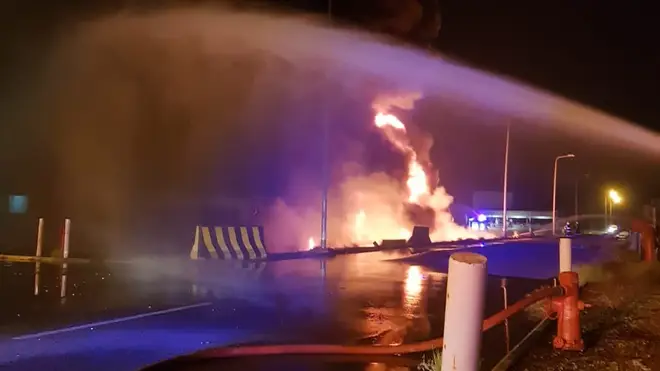
Iain Dale 7pm - 10pm
20 March 2022, 20:34

The salvo marked a serious escalation of rebel attacks on the kingdom.
Yemen’s Houthi rebels unleashed one of their most intense barrages of drone and missile strikes on Saudi Arabia’s critical energy facilities, sparking a fire at one site and temporarily cutting oil production at another.
The salvo marked a serious escalation of rebel attacks on the kingdom as the war in Yemen rages into its eighth year and peace talks stall.
The attacks did not cause casualties, the Saudi-led military coalition fighting in Yemen said, but struck sites belonging to one of the world’s most important energy companies and damaged civilian vehicles and homes.
The coalition also said it destroyed a remotely piloted boat packed with explosives dispatched by the Houthis in the busy southern Red Sea.
Hours after oil giant Aramco’s chief executive Amin H. Nasser told reporters the attacks had no impact on oil supplies, the Saudi energy ministry acknowledged that a drone strike targeting the Yanbu Aramco Sinopec Refining Company caused “a temporary reduction in the refinery’s production”.
The disruption, as oil prices spike in an already-tight energy market, “will be compensated for from the inventory”, the ministry said, without elaborating.
Another aerial attack later in the day struck a fuel tank at an Aramco distribution station in the port city of Jeddah and ignited a fire.
Later at night, the roar and thump of missile interceptors rattled the port city as the Saudi military coalition said it destroyed more projectiles over Jeddah.
Residents posted footage on social media showing streaks of light from missile defences pierce the dark sky.
The relentless wave of strikes revealed the expanding reach and precision of the rebels and the persistent gaps in the kingdom’s air defences.
A sophisticated strike in 2019 on Aramco oil facilities knocked out half the kingdom’s oil production and threatened to ignite a regional crisis, an attack that the US and Riyadh later alleged came from Iran.
The attacks on Sunday came as Saudi Arabia’s state-backed Aramco, the world’s largest oil company, announced its profits surged 124% in 2021 to 110 billion US dollars, a jump fuelled by renewed anxieties about global supply shortages and soaring oil prices.
Aramco, also known as the Saudi Arabian Oil Co, released its annual earnings after weeks of intense volatility in energy markets triggered by Russia’s invasion of Ukraine.
The international oil benchmark Brent crude spiked over 107 US dollars on Sunday after nearly hitting a peak of 140 US dollars earlier this month.
Saudi Arabia and the United Arab Emirates have so far resisted Western appeals to increase oil production to offset the loss of Russian oil as petrol prices skyrocket.
Yehia Sarie, a spokesman for Yemen’s Iran-backed Houthis, said the rebels had launched “a wide and large military operation” in retaliation for the Saudi-led “aggression and blockade” that has turned much of Yemen into a wasteland.
The escalation followed a flurry of diplomacy over the weekend in Oman’s capital of Muscat.
The UN special envoy for Yemen, Hans Grundberg, met with the chief Houthi negotiator and Omani officials to discuss “a possible truce during the holy month of Ramadan” in early April, the UN mission said.
The White House condemned the attacks, blaming Iran for supplying the Houthis with missile and drone parts, as well as training and expertise.
“It is time to bring this war to a close, but that can only happen if the Houthis agree to cooperate with the United Nations,” said US National Security Advisor Jake Sullivan.
“The United States stands fully behind those efforts.”

The Saudi-led military coalition reported aerial strikes on a range of facilities: an Aramco liquefied gas plant in the Red Sea port of Yanbu, an oil storage plant in Jeddah, a desalination facility in Al-Shaqeeq on the Red Sea coast and an Aramco oil facility in the southern border town of Jizan, among others.
The extent of damage on Saudi infrastructure remained unclear, and the ministry said only the Yanbu refinery saw a temporary drop in output.
A joint venture between Aramco and China, the 10 billion US dollar Yanbu Aramco Sinopec Refining Company on the Red Sea pumps 400,000 barrels of oil a day.
The Saudi Press Agency shared photos of fire engines dousing leaping flames with water and a trail of rubble wrought by shrapnel that crashed through ceilings and pocked apartment walls.
Other images showed wrecked cars and giant craters in the ground.
The barrage comes days after the Saudi-based Gulf Cooperation Council invited Yemen’s warring sides for peace talks in Riyadh, an offer dismissed out of hand by the Houthis, who demanded that negotiations take place in a “neutral” country.